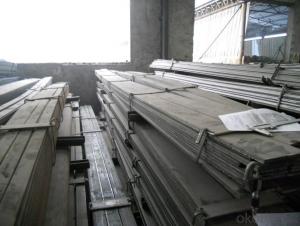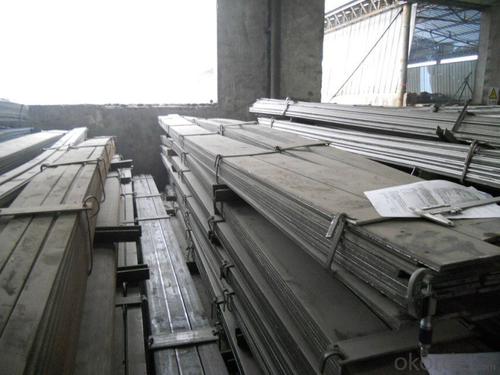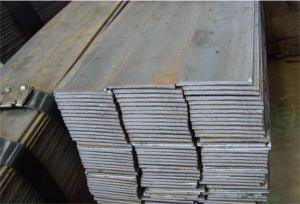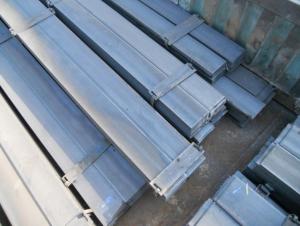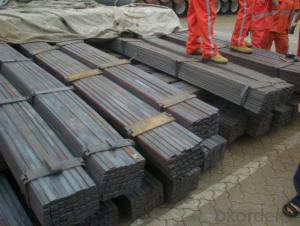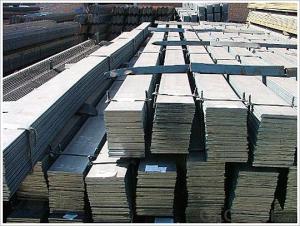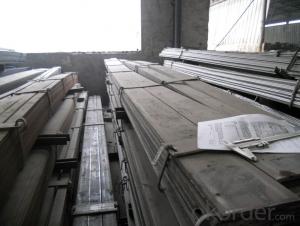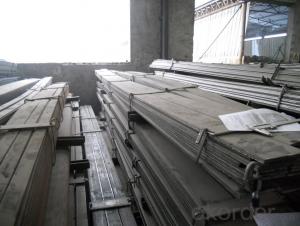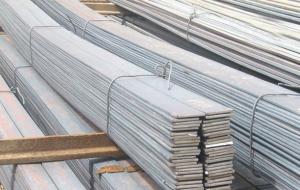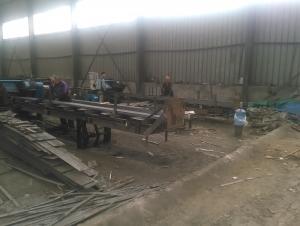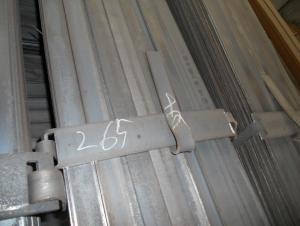Spring Steel Flat Bar with high quality
- Loading Port:
- Tianjin
- Payment Terms:
- TT or LC
- Min Order Qty:
- 25 m.t
- Supply Capability:
- 100 m.t/month
OKorder Service Pledge
OKorder Financial Service
You Might Also Like
Specification
Product Description:
OKorder is offering Spring Steel Flat Bar with high quality at great prices with worldwide shipping. Our supplier is a world-class manufacturer of steel, with our products utilized the world over. OKorder annually supplies products to European, North American and Asian markets. We provide quotations within 24 hours of receiving an inquiry and guarantee competitive prices.
Product Applications:
Spring Steel Flat Bar with high quality are ideal for structural applications and are widely used in the construction of buildings and bridges, and the manufacturing, petrochemical, and transportation industries.
Product Advantages:
OKorder's Spring Steel Flat Bar with high quality are durable, strong, and resist corrosion.
Main Product Features:
· Premium quality
· Prompt delivery & seaworthy packing (30 days after receiving deposit)
· Corrosion resistance
· Can be recycled and reused
· Mill test certification
· Professional Service
· Competitive pricing
Product Description:
Specification of Steel Flat Bar
Commodity: Mild Steel Flat Bar
Standard: GB;JIS
Material: Q195-235;SS400
Origin place: China
Thickness: 3mm-30mm
Width:20mm-200mm
Length: Max 12m
Certification: SGS/BV
Usage/Applications of Steel Flat Bar
Widely used for construction, Machinery manufacturing, Iron tower steel structure, Shipbuilding; Steel grating, Staircase, Bridge, Viaduct, Railway spare parts, Boilers making etc.
Packaging & Delivery of Mild Steel Flat Bar
Packaging Details: The Mild Steel Flat Bars are packed in bundles and loaded in 20 feet/40 feet container, or shipped by bulk cargo ,also we can do as customer's requirements.
Delivery Details:30~45 days upon the receipt of buyer payment by T.T. or L/C.
Production Flow of Steel Flat Bar
The Mild steel flat bar is made through three processes:
1.Feeding the material: Feeding the row material (the steel plate) to Slitting Line.
2.Slitting:The steel plate would be slitted into expected width by lengthways cutter.
3. Leveled and cutting: The plat bar would be ground into level by the grinder and then cut into required length
FAQ:
Q1: Why buy Materials & Equipment from OKorder.com?
A1: All products offered byOKorder.com are carefully selected from China's most reliable manufacturing enterprises. Through its ISO certifications, OKorder.com adheres to the highest standards and a commitment to supply chain safety and customer satisfaction.
Q2: How do we guarantee the quality of our products?
A2: We have established an advanced quality management system which conducts strict quality tests at every step, from raw materials to the final product. At the same time, we provide extensive follow-up service assurances as required.
Q3: How soon can we receive the product after purchase?
A3: Within three days of placing an order, we will begin production. The specific shipping date is dependent upon international and government factors, but is typically 7 to 10 workdays.
image:

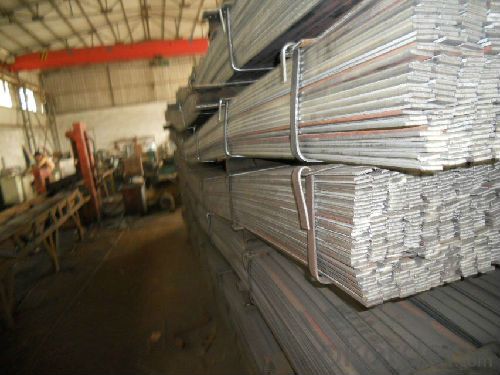
- Q: How do steel flat bars compare to aluminum flat bars?
- Steel flat bars and aluminum flat bars possess distinct properties and characteristics, rendering them appropriate for diverse applications. Regarding strength, steel flat bars generally exhibit a greater degree of robustness compared to aluminum flat bars. Steel is a denser and harder material, endowing it with superior tensile strength and rendering it less susceptible to deformation or bending under pressure. Consequently, steel flat bars are the preferred choice for applications demanding high load-bearing capacity or structural support. Conversely, aluminum flat bars are considerably lighter than their steel counterparts. Aluminum boasts a lower density, thereby conferring upon it a lightweight quality. This feature renders aluminum flat bars more manageable and transportable, particularly in applications where weight is a significant concern, such as in the aerospace or automotive industry. Another crucial factor to consider is corrosion resistance. Aluminum naturally forms an oxide layer, which imparts exceptional resistance to corrosion, rendering it ideal for outdoor applications or environments characterized by high levels of moisture or humidity. Conversely, steel is prone to rust and corrosion unless adequately coated or protected. As a result, steel flat bars are better suited for indoor applications or areas with minimal exposure to moisture. Lastly, cost represents an additional consideration. Generally, steel flat bars tend to be more cost-effective than aluminum flat bars. Steel is a widely available and economical material, while the production and processing of aluminum can incur greater expenses. In conclusion, steel flat bars offer greater strength and durability, qualifying them for heavy-duty applications and structural support. In contrast, aluminum flat bars are lighter, exhibit greater resistance to corrosion, and are better suited for applications where weight plays a pivotal role. Ultimately, the choice between steel and aluminum flat bars hinges upon the specific requirements of the application, taking into account factors such as strength, weight, corrosion resistance, and cost.
- Q: Do steel flat bars have a specific surface finish?
- Steel flat bars can possess a particular surface finish, which is contingent upon the manufacturing process and the desired final appearance. Several common surface finishes for steel flat bars are available. The first is mill finish, which refers to the untreated surface of the steel after it undergoes hot rolling. Another option is hot rolled pickled and oiled (HRPO), which involves treating the steel with an acid solution to eliminate surface impurities and subsequently coating it with oil to prevent rusting. Cold rolling, on the other hand, yields a smoother and more refined surface finish by rolling the steel at room temperature. Additionally, galvanization entails coating the steel with a layer of zinc for corrosion protection. Moreover, steel flat bars can undergo further surface treatments like grinding, polishing, or coating with paint or powder to serve specific aesthetic or functional purposes.
- Q: What is the difference between steel band and steel ring? The steel strip is flat steel and the steel ring is made of steel. Am I right?
- Steel rolls are also called steel belts. There is no difference between them. They are not flat steel
- Q: Can steel flat bars be used in the manufacturing of machinery?
- Yes, steel flat bars can be used in the manufacturing of machinery. Steel flat bars are versatile and commonly used in various industries, including machinery manufacturing. They offer several advantages such as high strength, durability, and resistance to corrosion, which make them suitable for machinery applications. Steel flat bars can be used for structural components, supports, brackets, and other critical parts in machinery. They provide stability and rigidity to the machinery, ensuring proper functioning and longevity. Additionally, steel flat bars can be easily machined, welded, and formed into desired shapes, making them ideal for customization in machinery manufacturing.
- Q: What is the surface area of flat steel 100*3 meters per metre?
- Flat steel can be finished steel, or can be used as the blank of welded pipe and thin slab for laminated sheet rolling. Main application: flat steel is used as a material, used for making iron, tools and machinery parts, and used as frame structures and escalators for buildings.
- Q: What is the difference between a steel flat bar and a steel hex bar?
- The main difference between a steel flat bar and a steel hex bar lies in their shape and design. A steel flat bar, as the name suggests, is a long, rectangular-shaped bar with a flat surface on all sides. It has a uniform thickness throughout its length and is typically used for structural applications, such as supports, braces, and framing. The flat surface allows for easy fastening or welding to other components. On the other hand, a steel hex bar is a bar with six equal sides, forming a hexagonal shape. This unique design provides increased strength and stability compared to a flat bar. The hexagonal shape also offers better grip and torque resistance, making it suitable for applications that require high tensile strength, such as machinery, tools, and hardware components. In terms of versatility, a steel flat bar can be easily manipulated, cut, or bent to fit various shapes and sizes, making it a more flexible option for different projects. Conversely, a steel hex bar is more rigid and less malleable due to its six-sided structure, limiting its adaptability but enhancing its strength. In summary, while both steel flat bars and steel hex bars are made from the same material, their distinct shapes and designs make them suitable for different applications. The flat bar is commonly used for structural purposes, while the hex bar is preferred for applications requiring higher strength and torque resistance.
- Q: How do steel flat bars perform in high-humidity environments?
- Steel flat bars generally perform well in high-humidity environments, but their performance can be affected by certain factors. Steel is known for its strength, durability, and corrosion resistance, which makes it suitable for various applications. However, in high-humidity environments, the presence of moisture can accelerate the corrosion process, potentially causing rust and deterioration of the steel. To mitigate the effects of high humidity, steel flat bars can be coated with protective finishes or treated with corrosion-resistant coatings such as galvanization. These coatings create a barrier between the steel and the surrounding environment, preventing or slowing down the corrosion process. However, it is important to note that the effectiveness of these coatings can vary depending on the quality of the coating and the severity of the humidity. In extremely humid or corrosive environments, it may be necessary to use stainless steel flat bars, which have a higher resistance to corrosion. Regular maintenance and inspection are also crucial in high-humidity environments to identify any signs of corrosion or damage early on. This can involve cleaning the steel regularly, removing any accumulated moisture or debris, and applying additional protective coatings if necessary. Overall, while steel flat bars can perform well in high-humidity environments, it is essential to consider the specific conditions and take appropriate measures to ensure their long-term durability and performance.
- Q: Are steel flat bars suitable for automotive applications?
- Yes, steel flat bars are suitable for automotive applications due to their strength, durability, and versatility. They are commonly used in various automotive components such as frames, suspension systems, and body reinforcements. Steel flat bars provide structural support and can withstand the rigors of automotive use, making them a reliable choice for such applications.
- Q: Can steel flat bars be used for toolmaking?
- Yes, steel flat bars can be used for toolmaking. They are often used to create various types of tools due to their durability, strength, and versatility. The flat shape of steel bars makes them suitable for forging, shaping, and machining into different tool components.
- Q: What is the difference between hot rolled and cold rolled steel flat bars?
- The main difference between hot rolled and cold rolled steel flat bars lies in the manufacturing process. Hot rolled steel flat bars are produced by heating a billet of steel above its recrystallization temperature and then rolling it into the desired shape. This process results in a rougher surface and slightly rounded edges. On the other hand, cold rolled steel flat bars are formed by passing the hot rolled bars through a series of rollers at room temperature, which gives them a smoother surface, tighter tolerances, and sharper edges. Additionally, cold rolled steel flat bars tend to have a higher strength and a more uniform thickness compared to hot rolled ones.
Send your message to us
Spring Steel Flat Bar with high quality
- Loading Port:
- Tianjin
- Payment Terms:
- TT or LC
- Min Order Qty:
- 25 m.t
- Supply Capability:
- 100 m.t/month
OKorder Service Pledge
OKorder Financial Service
Similar products
Hot products
Hot Searches
Related keywords
